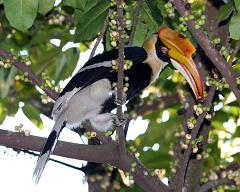Hornbills, also known by its scientific name “Bucerotidae” are a family of bird found in tropical and sub-tropical Africa and Asia.

When it’s time for the female hornbill to lay her eggs, she finds a hollow in a tree trunk and builds her nest.
While she’s busy setting up her nest, the male begins sealing up the hole in the tree with mud, bird droppings, and chewed food.
He leaves a small hole for her beak, and spends the rest of her roosting time bringing her food and feeding her through this hole.
When the chicks hatch, the mother hornbill breaks out of the mud prison and reseals her babies in the tree trunk, leaving, again, a hole through which they may be fed by both parents.
Although the process looks like male domination, the mother bird breaks out as soon as her chicks are hatched, the sealing is probably not strong enough to keep her in against her will.
The function of this behavior is to protect the nesting site from rival hornbills, and predators such as monkeys and tree snakes that love to eat hornbill eggs.
We can say that the nests are sealed with a kiss.
